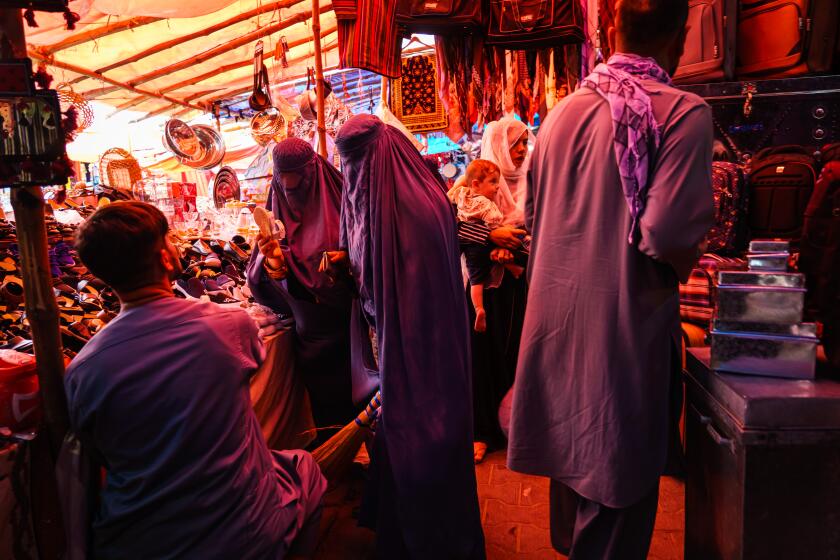U.S.-run airlift from Taliban-occupied Kabul picks up pace but faces daunting problems
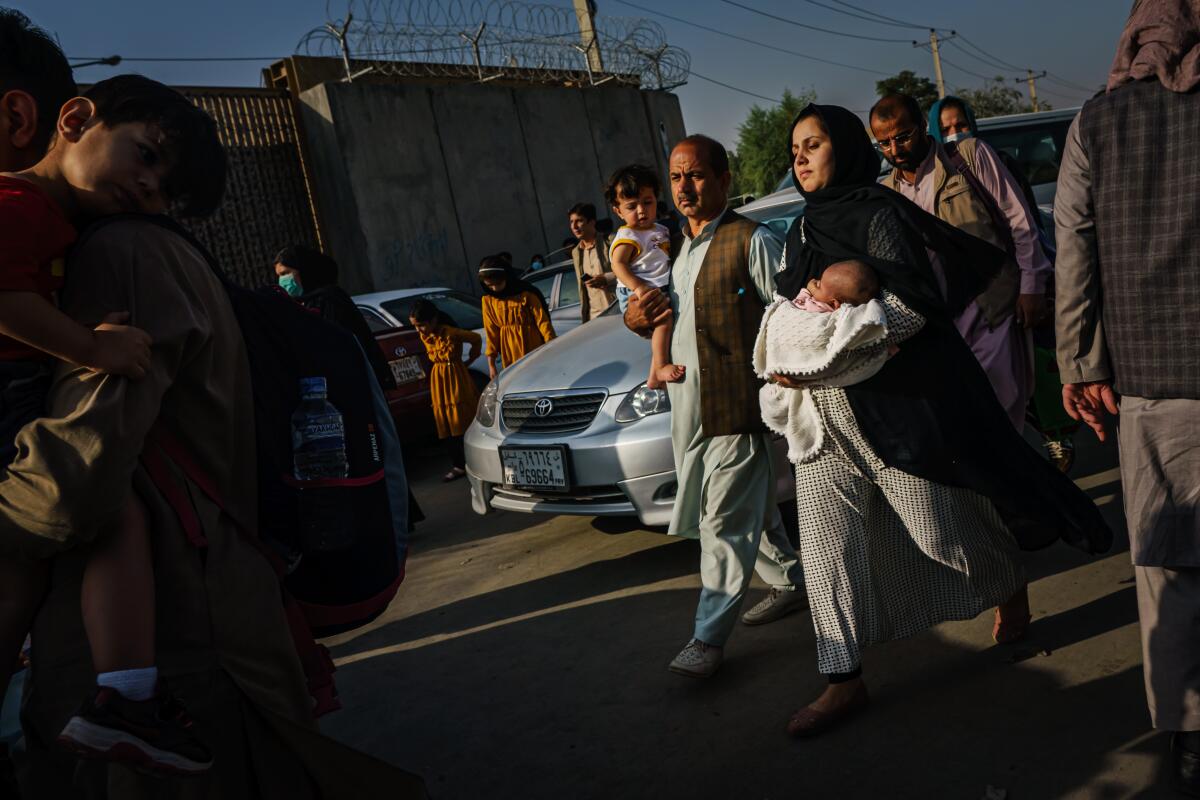
- Share via
KABUL, Afghanistan — Faced with mounting criticism of a chaotic exit from Afghanistan, the U.S. and its allies Friday stepped up evacuation efforts from Kabul, where thousands of desperate people ringed the airport even as a semblance of normality returned to other parts of the capital.
With bedlam at the airport a daily event since the Taliban’s takeover of Kabul on Sunday, even those with permission to leave have faced a gantlet of crushing crowds and edgy Taliban fighters using truncheons, sticks, whips, rifle butts and bullets to disperse people around the airport’s environs.
The U.S. administration is weathering intense disapproval, both internationally and domestically, for failing to organize the departure of U.S. citizens and vulnerable Afghans well before the planned exit of American troops by the end of this month.
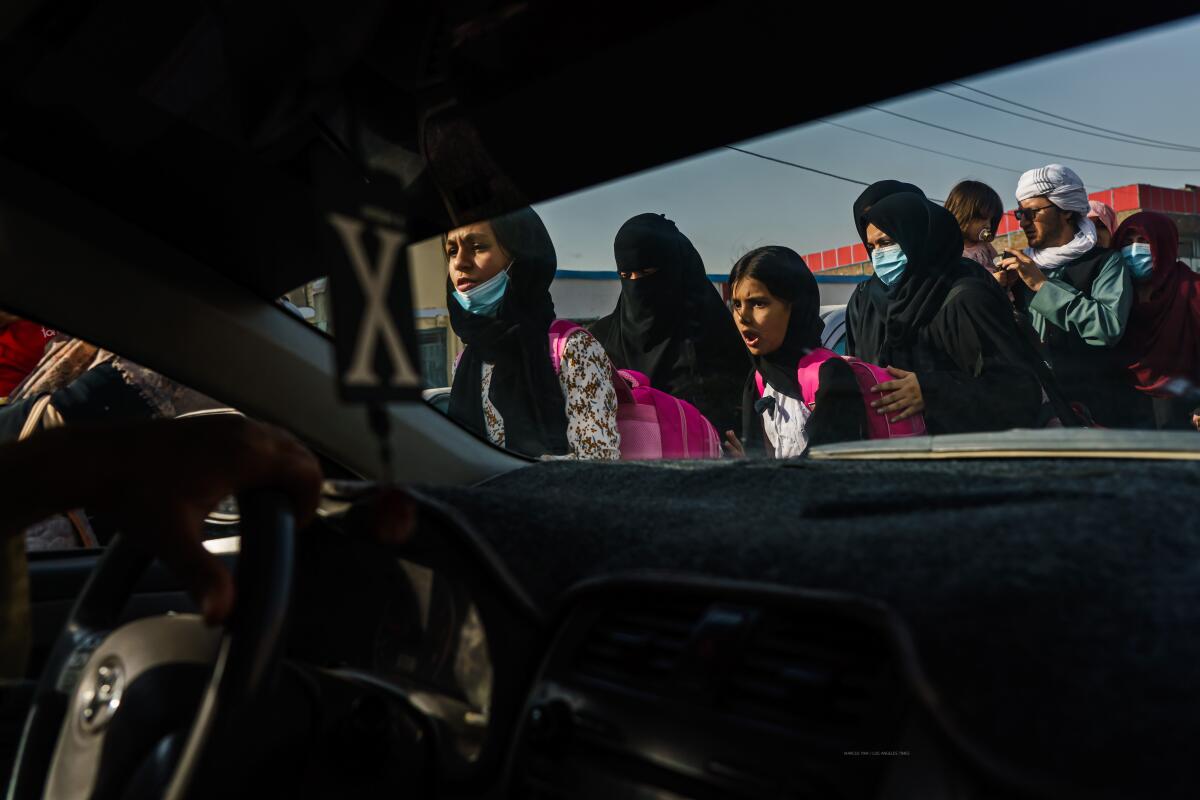
In Washington, President Biden promised that any American in Afghanistan who wants to depart will be helped, pledging: “We will get you home.”
He said the United States was “making the same commitment” to Afghans eligible to leave — an assertion that was immediately called into question by those who have observed the scope of the disorder and panic outside the gates of the airport, the only bit of U.S.-held territory remaining in the country.
Illustrating the difficulty and complexity of the U.S. effort, evacuation flights stopped for several hours before the president spoke due to a bottleneck at a U.S. air base in Qatar that is being used as a transit point. The flights resumed later Friday.
U.S. and its allies Friday stepped up evacuation efforts from the Afghan capital, Kabul, where thousands of desperate people ringed the airport
In Kabul, those able to shove their way to the airport told of finding no one to receive them; Afghan diplomats outside the country and émigrés scattered across the United States fielded a constant stream of phone calls from compatriots back home asking for help.
U.S. officials say there are some 6,000 American troops securing the airport, with no publicly disclosed plans to move beyond its perimeter to pluck to safety those wanting to leave. But there were reports that one such rescue had taken place: 169 Americans were ferried by helicopter from a hotel rooftop to the nearby airport.
Biden said Friday that the U.S. military has managed to evacuate some 13,000 people since Saturday, the day before Kabul fell, including 5,700 on Thursday, the highest one-day tally yet. Pentagon spokesman John Kirby said most of those flown out Friday were Afghans.
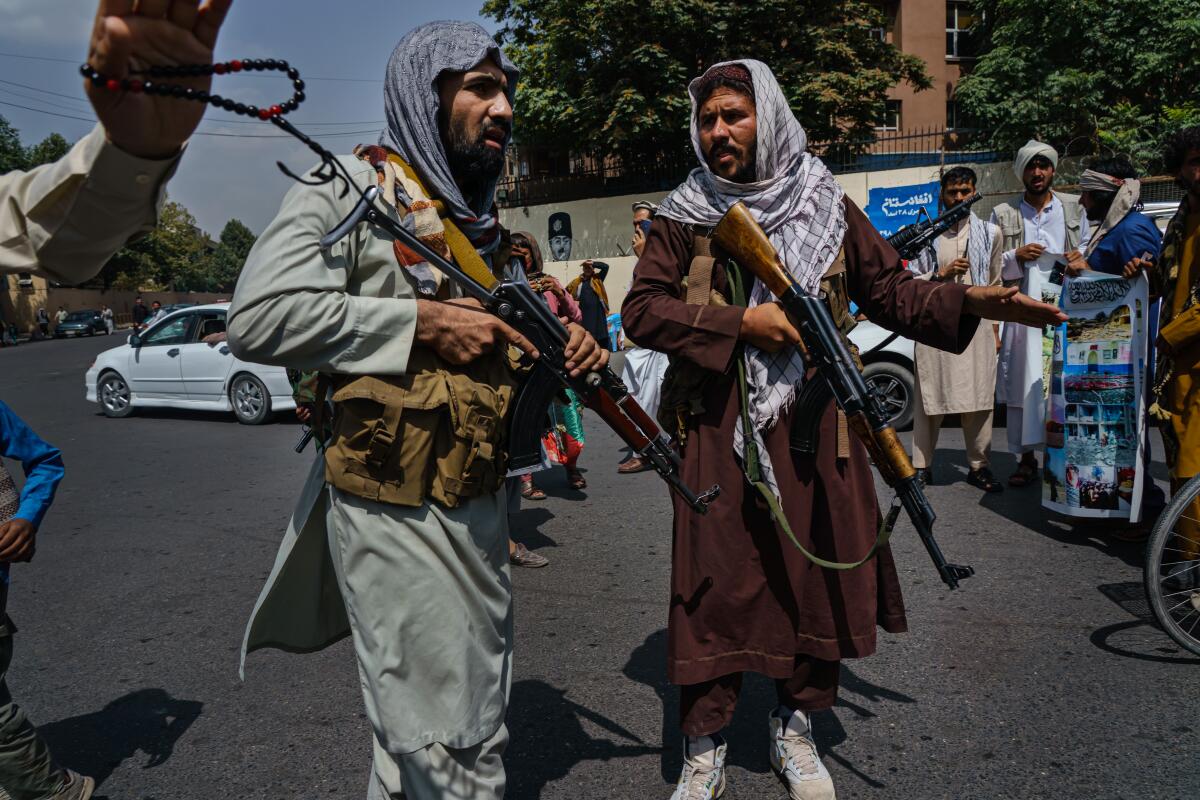
International organizations made urgent calls to aid those seeking to leave Afghanistan.
“As of today, those who may be in danger have no clear way out,” said Shabia Mantoo, a spokeswoman for the United Nations High Commissioner for Refugees. She urged the countries neighboring Afghanistan to keep their borders open.
Other countries that sent troops as part of the onetime NATO force in Afghanistan were also taking part in the evacuation effort. On Friday, the 30-nation alliance’s foreign ministers, meeting by videoconference, promised “close operational cooperation” at the Kabul airport.
“Our immediate task now is to meet our commitment to continue the safe evacuation of our citizens, partner country nationals and at-risk Afghans, in particular those who have assisted our efforts,” they said in a statement.
But the near-impossibility of reaching the airport has meant that many of the departing flights have left with empty seats. One report said a German military flight left with only seven passengers.
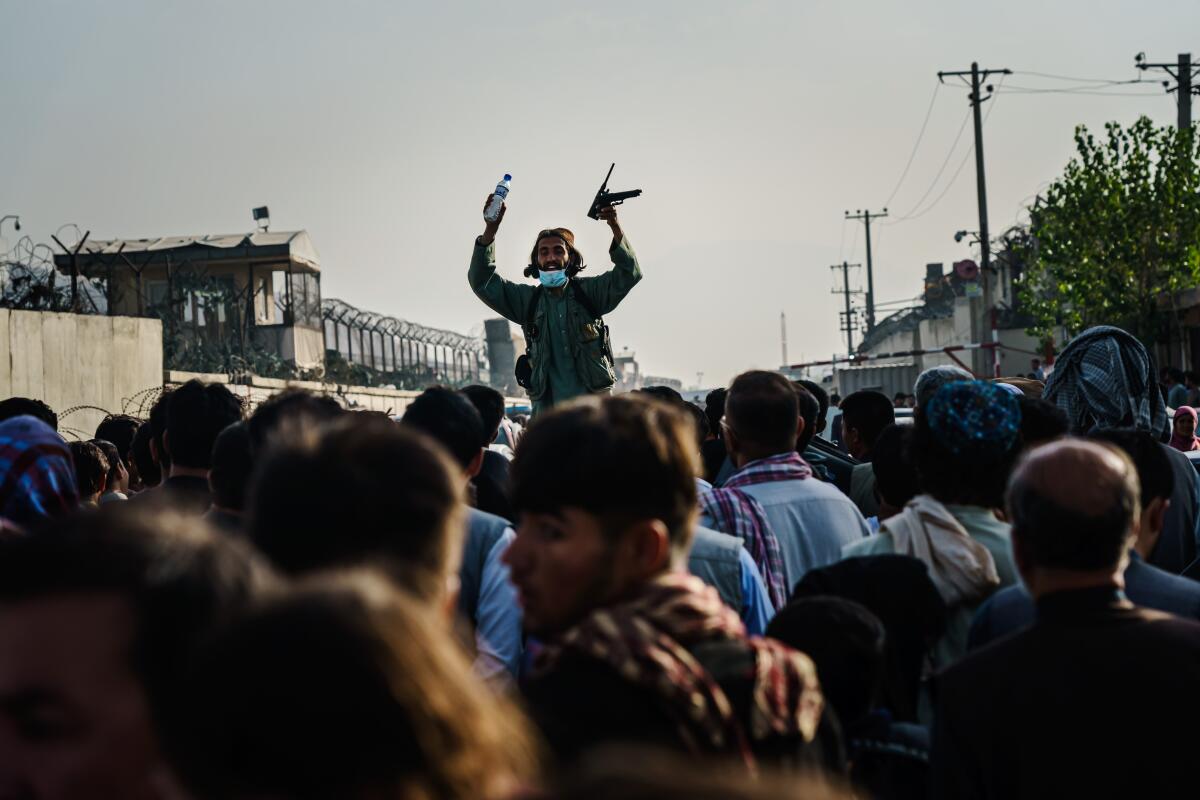
Away from the airport, there was the almost humdrum rhythm of a Friday, the first day of the weekend here and the most important prayer day of the week. In advance of Friday prayers, the Taliban called for unity — and handed imams the task of trying to persuade people not to leave.
Friday prayers at Kabul’s main mosque brought one notable public appearance: Khalil Rahman Haqqani, a senior member of the Haqqani network, a notorious Taliban offshoot.
Haqqani is reported to have been tasked by the Taliban with overseeing security in Kabul; fittingly, his sermon emphasized what he said was the dawn of a new period of peace in the capital and the country.
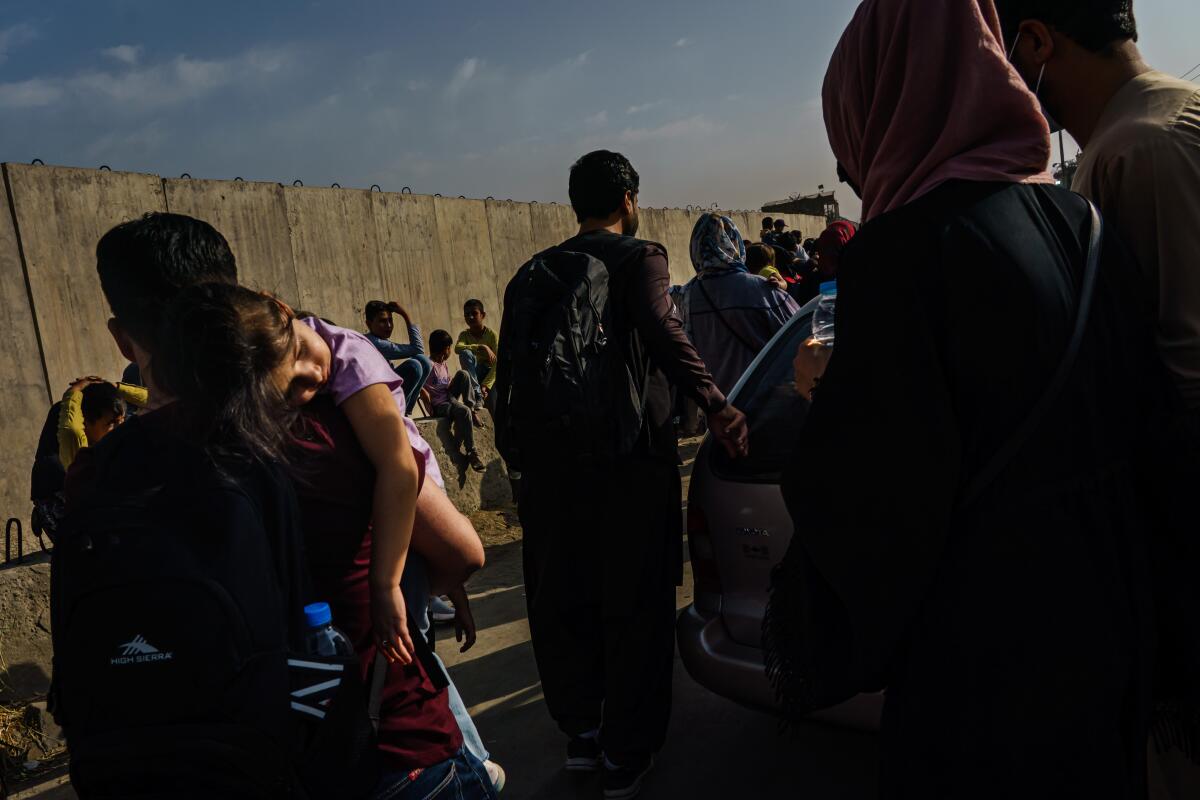
The fighter-preacher added that all who worked with the former government, even former Afghan President Ashraf Ghani, were to be given amnesty — an oft-repeated talking point of Taliban leaders in recent days.
But a confidential security assessment prepared for the U.N. by the Rhipto Norwegian Center for Global Analyses — and seen by the Los Angeles Times — spoke of the Taliban trying to hunt down some of its former adversaries, going so far as “arresting and/or threatening to kill or arrest family members of target individuals unless they surrender themselves to the Taliban.”
Breaking News
Get breaking news, investigations, analysis and more signature journalism from the Los Angeles Times in your inbox.
You may occasionally receive promotional content from the Los Angeles Times.
“The reports that we have been getting from multiple sources are that it’s not just rogue Taliban fighters seeking revenge, but that they’re hunting former people in the security services, Afghan special forces and police,” Christian Nellemann, who heads the group behind the report, said in an interview Friday.
Amnesty International said Friday that even before completing their takeover of the country, Taliban fighters had been killing ethnic and religious minorities, as well as targeting other opponents. Agnes Callamard, Amnesty International’s secretary general, said the July killings of nine ethnic Hazara men in Ghazni province were “a reminder of the Taliban’s past record, and a horrifying indicator of what Taliban rule may bring.”
For those fearing such retribution, nerves were rubbed raw. A 29-year-old woman named Madina said that when the capital fell, her mother, a green-card holder who lives in Los Angeles, was visiting to help the family apply for U.S. visas.
Madina, who asked to be identified by her first name for safety, said she, her younger sister, her husband and their sons, ages 7 and 2, as well as her mother, had changed locations twice since the Taliban takeover, because her husband, who had worked for the former president, was being hunted by the fighters.
Outside a window, she could see Taliban patrolling, stopping people for questioning. Even if the family does receive documentation, Madina said, her mother was balking at trying to brave Taliban checkpoints and the chaos at the airport perimeter.
“She is telling me, ‘If we die, we die together,’” Madina said, weeping. “We will all stay together and suffer what will come to us.”
Times staff writers Yam reported from Kabul and Bulos from Dubai, United Arab Emirates. Staff writers Laura King and Tracy Wilkinson in Washington and Molly Hennessy-Fiske in Houston contributed to this report.
More to Read
Sign up for Essential California
The most important California stories and recommendations in your inbox every morning.
You may occasionally receive promotional content from the Los Angeles Times.
